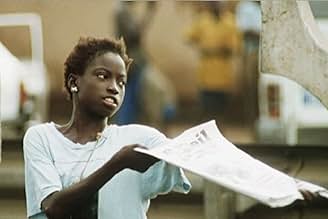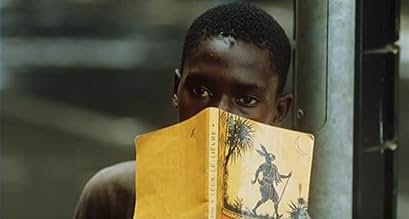Füge eine Handlung in deiner Sprache hinzuA girl sells copies of Soleil, the government paper.A girl sells copies of Soleil, the government paper.A girl sells copies of Soleil, the government paper.
- Regie
- Drehbuch
- Hauptbesetzung
- Auszeichnungen
- 9 Gewinne & 2 Nominierungen insgesamt
Empfohlene Bewertungen
The Sun is a newspaper, and the girl is a crippled girl living on the streets of Senegal in poverty with her blind grandmother. The film is basically a parable of her fortitude and the adversity she faces, with inspiring gestures of solidarity and thought-provoking elements of strife--even her enemies are sympathetic in the sense that they, too, struggle with poverty. This would be a wonderful film to show to children for discussion.
the movie is about the life of Sili, a young handicapped girl in Dakar, Senegal. it shows her struggles to earn a living in a world which is cruel yet can be wonderful too, if you have the courage and the go getter attitude to battle it out. i found her story to be very inspiring. also, you get to see dakar, senegal as it is now. a third world nation which is developing and yet at the same time the poverty which is present everywhere. highly recommended !!!
because IMDb requires even more commentary, here are some of my personal observations. even though the people are poor they are stoic about it. that is an uniquely African attitude. the frustration of individual's is contained within the body/soul until it comes out in a single anguished scream. or so it seems to me. also, the depiction of poverty in this movie is spot on. if you have never been to a third world country, well this will shock you, but it's totally realistic. actually, real life is much worse, the part where she flashes her money, in real life somebody would have taken it for sure. so the movie is kinda naive, but overall i liked the feel good message of the movie.
because IMDb requires even more commentary, here are some of my personal observations. even though the people are poor they are stoic about it. that is an uniquely African attitude. the frustration of individual's is contained within the body/soul until it comes out in a single anguished scream. or so it seems to me. also, the depiction of poverty in this movie is spot on. if you have never been to a third world country, well this will shock you, but it's totally realistic. actually, real life is much worse, the part where she flashes her money, in real life somebody would have taken it for sure. so the movie is kinda naive, but overall i liked the feel good message of the movie.
Sili, a young teenage street kid, decides to hit the streets and sell newspapers to make ends meet. The other newspaper boys don't like her moving on their territory and give her a hard time. This is an observing piece on street life poverty.
Le Franc (1994) & The Little Girl Who Sold The Sun (1999) are the first two entries in late Senegalese director Mambéty's whimsical yet very socially relevant trilogy of films titled "Tales of Ordinary People". What a great loss, then, that the aeuteur's inopportune death in 1998 meant that they were also the only two entries in an unfortunately unfinished trilogy.
Both films are relatively short feature films, clocking in at about 45 minutes each. Similar in their inspiring messages, light satirical approach, and allegorically important commentary, there is little doubt that the planned third and final installment would have followed in the same vein and been as successful.
Like the director's feature films, they include impressive performances by non professional actors and actresses, and the parables are accompanied by catchy, engaging soundtracks that exhibit the culturally unique sounds of African music. Le Franc in particular makes good use of the congoma, a little known unique looking instrument most similar to a guitar. Not to be outdone, The Little Girl Who Sold The Sun features an irresistible scene with our young heroine wearing adorable yellow plastic sunglasses, grooving and singing along to a radio tune that the local street children pay a boy in a wheelchair to play for them. Indeed, there are several parts in these films that could easily be confused for quality music videos!
The most notable shortcoming is the length of these films, leaving much to audience imagination and not having quite enough time to fully develop character arcs. There is also a slight disconnect in their presentation as both mini fairy tales and as allegories that should convey cultural, social, and political commentary. In Le Franc, the protagonist's decisions are foolish, frustrating, and difficult to believe. In The Little Girl Who Sold The Sun, the protagonist is a zesty combination of Helen Keller's perseverance in the face of disability and marginalization, Mother Teresa's charitable ways, and Pollyanna's undeterrable optimism. While the former short film is more comical in its little-guy-who-overcomes-the-odds-in-the-name-of-music tale, the latter is more inspirational in its little-girl-who-overcomes-the-bigger-boys-despite-her-handicap tale. The narrative would have been more effective if it came across as more plausible and sincere. One example of this unrealistic storytelling is showing a sexist police sergeant accusing her of theft with nothing to go on but what he sees with one glance- namely her disability and gender- followed by the police captain immediately taking her side when she reaches the station, even going so far as to release another woman being held there, simply because she tells him that she was also falsely accused. Fine for a fairy tale, but in real life things don't go from wrong to right that magically. But. One must admit that the title is quite clever- The Sun is "Le Soleil", the government's newspaper that our heroine bravely takes on as the first female newspaper vendor in the male monopolized workforce.
All in all, two great humanist films well worth the time, even if only to be introduced to some melodiously unique songs!
Both films are relatively short feature films, clocking in at about 45 minutes each. Similar in their inspiring messages, light satirical approach, and allegorically important commentary, there is little doubt that the planned third and final installment would have followed in the same vein and been as successful.
Like the director's feature films, they include impressive performances by non professional actors and actresses, and the parables are accompanied by catchy, engaging soundtracks that exhibit the culturally unique sounds of African music. Le Franc in particular makes good use of the congoma, a little known unique looking instrument most similar to a guitar. Not to be outdone, The Little Girl Who Sold The Sun features an irresistible scene with our young heroine wearing adorable yellow plastic sunglasses, grooving and singing along to a radio tune that the local street children pay a boy in a wheelchair to play for them. Indeed, there are several parts in these films that could easily be confused for quality music videos!
The most notable shortcoming is the length of these films, leaving much to audience imagination and not having quite enough time to fully develop character arcs. There is also a slight disconnect in their presentation as both mini fairy tales and as allegories that should convey cultural, social, and political commentary. In Le Franc, the protagonist's decisions are foolish, frustrating, and difficult to believe. In The Little Girl Who Sold The Sun, the protagonist is a zesty combination of Helen Keller's perseverance in the face of disability and marginalization, Mother Teresa's charitable ways, and Pollyanna's undeterrable optimism. While the former short film is more comical in its little-guy-who-overcomes-the-odds-in-the-name-of-music tale, the latter is more inspirational in its little-girl-who-overcomes-the-bigger-boys-despite-her-handicap tale. The narrative would have been more effective if it came across as more plausible and sincere. One example of this unrealistic storytelling is showing a sexist police sergeant accusing her of theft with nothing to go on but what he sees with one glance- namely her disability and gender- followed by the police captain immediately taking her side when she reaches the station, even going so far as to release another woman being held there, simply because she tells him that she was also falsely accused. Fine for a fairy tale, but in real life things don't go from wrong to right that magically. But. One must admit that the title is quite clever- The Sun is "Le Soleil", the government's newspaper that our heroine bravely takes on as the first female newspaper vendor in the male monopolized workforce.
All in all, two great humanist films well worth the time, even if only to be introduced to some melodiously unique songs!
Not a story, but a chapter of story in the life of a truly physically crippled child. This came across as a fine children's film.
To West African eyes (the original audience), the poverty depicted is an accepted reality. But to my American eyes, the poverty and plight of these children utterly overpowered the plot. More interesting than entertaining. Unforgettable on its own terms.
To West African eyes (the original audience), the poverty depicted is an accepted reality. But to my American eyes, the poverty and plight of these children utterly overpowered the plot. More interesting than entertaining. Unforgettable on its own terms.
Wusstest du schon
- VerbindungenFeatured in A Story of Children and Film (2013)
Top-Auswahl
Melde dich zum Bewerten an und greife auf die Watchlist für personalisierte Empfehlungen zu.
Details
- Erscheinungsdatum
- Herkunftsländer
- Offizieller Standort
- Sprachen
- Auch bekannt als
- Das kleine Mädchen, das die Sonne verkaufte
- Drehorte
- Produktionsfirmen
- Weitere beteiligte Unternehmen bei IMDbPro anzeigen
- Laufzeit45 Minuten
- Farbe
- Sound-Mix
- Seitenverhältnis
- 1.85 : 1
Zu dieser Seite beitragen
Bearbeitung vorschlagen oder fehlenden Inhalt hinzufügen

Oberste Lücke
By what name was Le petite vendeuse de soleil (1999) officially released in Canada in English?
Antwort







